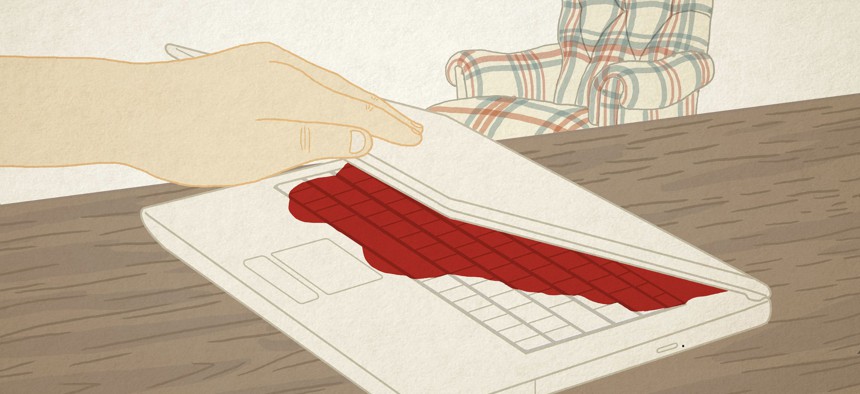
Fanqiao Wang for Quartz
How Violent ISIS Videos Help Mobilize New Recruits
Aug. 19 will mark one year since James Foley’s execution was posted on YouTube. Such videos offer, to certain minds, a paean to masculinity and a path out of powerlessness.
It’s been a year and many of us still can’t shake the image.
The crystalline shot of James Foley, shaved face and head, barefoot, wrists cuffed behind his back, wearing bright orange, kneeling. His executioner stands, masked, clothed all in black, holding a knife whose blade catches the sun. He speaks as instructed and grimaces. He marshals what dignity he can, but there’s none to be had. The screen fades to black. It fades up again on a shot of Foley’s prone body. The next shot is of Foley’s executioner holding the American Steven Sotloff, warning US president Barack Obama that this will be the next victim.
Aug. 19 marks exactly one year since the video of Foley’s execution was posted on YouTube by ISIL. The video was a demand to the United States to cease airstrikes against the group during its persecution of Iraq’s Yazidis in Sinjar. US airstrikes continued unabated, as did the parade of hostages, beheadings and threats. One year on, many of us have likely forgotten the specific reasons for this macabre dance of demand and denial. What we do remember, and all too vividly, is the victims’ faces at the end.
ISIL had been years in the making, its progenitors and architects deeply implicated in the waves of sectarian violence that had nearly ripped Iraq apart several times over in the years since the American-led invasion of 2003. And it was two months prior to these videos that ISIL declared itself a caliphate (the institution of legitimate Muslim political rule), demanding that devout Muslims around the world swear an oath of allegiance to ISIL and Abu Bakr al-Baghdadi, its ruler. But it was these slickly produced beheading videos, circulated endlessly and everywhere by way of digital technologies, that made ISIL a household name.
How do these videos work? Why did ISIL make them? As with so many things connected to ISIL, there’s far more noise than knowledge surrounding the topic. This is partly because much remains unknown about the group. ISIL’s penchant for killing journalists and the strength of its propaganda machine—adept at disseminating and popularizing a particular image—have made it extraordinarily difficult to gather independent and reliable information about the organization. But the dearth of insight here also has to do with the fog of strategic expertise that tends to collect around such acts of violence, obscuring as much as clarifying their meaning and purposes.
Military, security and terrorism experts have long concluded that the videos are a tactic, a strategy to obtain specific outcomes: deterring US airstrikes, recruiting new fighters and sowing terror among enemies. In other words, there’s a clear consensus that the meaning and purpose of these videos can be understood in terms of the relation between means and ends.
But this says nothing about why the violence here was so very carefully arranged, scripted and performed. Nor does it say much about how these videos work to recruit whom; or in what way, precisely, they “sow terror” and among which audiences (more on this below).
To be sure, the last words Foley and Sotloff are forced to speak in these stilted, grisly dramas are all about means and ends. And lest we miss the point, the executioner explains it repeatedly: killing is an act of direct retribution for American attacks on ISIL, and the next hostage is leverage to make it stop.
But while some of the verbal rhetoric hews to the language of means and ends, there’s also a visual rhetoric at work here, one that conveys meaning sometimes in tandem with, sometimes independently of the words spoken, and that operates differently on viewers than an argument or a speech. And it’s in the visual rhetoric—what the hostages are made to say and do and suffer, how their bodies are positioned when alive and when dead—that the meaning and significance of ISIL’s violence is fully and completely elaborated.
Each of these videos is much more than just a record of a violent death. They are performances of violence deliberately scripted to humiliate the victims.
The roles in the unfolding drama are very carefully cast. In the first video, the executioner spells out the larger stakes in no uncertain terms: addressing Obama directly—and gesticulating at oddly timed moments with his knife, the man the press would dub “Jihadi John” instructs viewers that the United States is no longer fighting an insurgency, but a legitimate Islamic state, a caliphate that has been accepted by Muslims around the globe. This functions as a declaration of equivalence status between the US and ISIL, and becomes the ground on which the executioner proceeds to enact an inversion of previous relations of domination and power.
The last words Foley was forced to speak, “I guess, all in all, I wish I wasn’t American,” say much about how this inversion is performed: he and Sotloff are not just expendable hostages to be duly killed, but are transformed into archetypes whose humiliation becomes that of the American nation. In other words, these two men become the American body politic upon which retaliatory humiliation is literally reinscribed.
Retaliatory humiliation has a particular meaning in contemporary radical Islamist rhetoric and writing: it derives from a definition of humiliation as the unjust imposition of impotence on Islam and Muslims. This definition of humiliation equates political and economic powerlessness with the imperilment of a certain kind of masculine agency—a dominant masculinity understood as the ability to protect, provide and control.
This sense of powerlessness has many different sources. High unemployment in many Muslim-majority countries has jeopardized men’s ability to marry, engage in sanctioned sexual relations, and provide for their families. Then there’s the challenge to conventional gender roles posed by the entry of women into the workforce, along with women’s visible political activism and increased access to higher education. The brutal suppression of domestic dissent or opposition by authoritarian regimes has long produced experiences of political impotence, and the disappointing outcomes of the revolutions associated with the “Arab Spring” have only deepened many of these frustrations.
Finally, the legacies of colonialism, longstanding Euro-American support for these authoritarian regimes, drone strikes, Israeli occupation and the dynamics of globalization combine to intensify perceptions of Muslim impotence relative to America and Europe. This perception is continually revivified by the flow of images of bloodied Muslim bodies delivered by a burgeoning array of video, satellite and digital media.
By extension, then, retaliatory humiliation means imposing impotence upon those who have humiliated Islam. Doing so enacts a masculine agency seen as necessary to defend Islam and restore strength and greatness to the Muslim community.
Consider the shorn heads of the captured men, wearing bright orange clothing akin to the jumpsuits worn by inmates at Guantánamo Bay prison. They kneel in postures of submission at the feet of their executioner, who stands over them, legs apart, masked, clothed in black from head to toe. The hostages are forced to use their last breath on earth to speak the words of their murderers; only their eyes visibly hint at what must have already been done to get each man to follow this script, to play the designated role in the spectacle of his own murder.
Then, with no prelude and little ceremony, there’s the quick move to the kill; the quick camera cut to the prone body, severed head resting upon it; the slow pan down its length, steady, to reveal the cuffed wrists, the bare feet, the painful vulnerability. The slow fade to black, then up; the killer now gripping the collar of the next kneeling victim, as if holding an unclean animal; the threat and promise of an encore performance whose ritualized elements we already know.
The victims are forcibly and multiply exposed: their names, their faces, their fear, their powerlessness, and later, their bodies, are there for all to see. By contrast, virtually all personal aspects of the executioner’s identity are hidden by the black garb of ISIL. There’s one notable exception: his British accent, which denies English-speaking viewers the comfort of seeing him as culturally alien. All that is left to see and know of him is his maleness, height, stance, stillness, stiff acting, and the apparent calm—even casualness—he brings to the execution.
Scholarship by authors like Dave Grossman and Randall Collins has shown that it’s far easier to kill at a distance with drones and bombs than to kill at close range and without a gun—where there’s no escape from the pleas and screams of your victim. Taken together, all of these details constitute “Jihadi John” as the ideal, masculine Islamist militant. By extension, they constitute ISIL itself as unstoppable, fearless hard, dominant—the ideal Islamist force, and the only one sufficiently potent, sufficiently masculine enough to bring the Great Humiliator to its knees, literally and figuratively.
The point here is not to assess whether and to what extent such constructions of humiliation are legitimate or accurate. Rather, the point is that, within the world of meaning constructed by these performances of violence, the video’s “efficacy” depends upon emotional resonance rather than fact, which makes matters of accuracy entirely irrelevant. This means that the power and impact of the beheading videos was never really tied to ending US airstrikes (an unlikely outcome in any case), but was always a matter of the extent to which they resonated with or horrified particular audiences.
And this has to do with how these performances work once they begin to travel the globe via digital technologies, for the endless circulation and repetition of these beheading videos actually involves a visual re-enactment of the violence. This makes available to millions of people the vicarious experience of witnessing the humiliation, as if they had been there—and even, in some extended sense, to feel virtually implicated in it.
Unlike the amorphous aim of “sowing terror” often attributed to ISIL, this effect of vicarious experience provides a sense of how and why these videos were and still are particularly horrifying and difficult to watch for many Americans. It also suggests how and why they continue to resonate affectively among some Muslim men aggrieved by both macro-historical patterns of powerlessness and quotidian experiences of impotence, and who feel compelled by a conception of masculinity in which men are responsible for restoring Islam and the Muslim community to its rightful stature.
This is no magic bullet that explains all–there is no such thing. Yet it does help explain how violent ISIL videos like this help mobilize new recruits from Europe to Africa, and North America to the Middle East.
It also provides traction on the more elusive production of digital support for ISIL among those who are unlikely to actually join it—sometimes referred to as “soft-sympathizers.” Such sympathizers are partly responsible for the mass dissemination of ISIL propaganda [PDF] by, for example, hijacking World Cup hashtags to retweet beheading videos. Among these armchair Islamists, such performances work almost pornographically: enacting the conquest of impotence, they offer vicarious virility and the voyeuristic excitement of sensationalized violence without having to put anything real at risk.
Of course, for some, to even speak of “meaning” and “purpose” in connection with these beheading videos is to already accord the subject far more legitimacy than it deserves. Many argue that violence this horrific indicates a savagery or sadism with no real purpose beyond itself, and which places the perpetrators outside of the realm of both rationality and humanity.
Certainly, there’s a great deal we still don’t know about ISIL. But as the one-year anniversary of their surge to global attention approaches, there’s a fair amount hidden in plain view.




